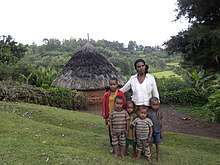Kambaata people
Kambaata (ከምባታ) is the name of the people who speak the Kambaata language Their land is in south central Ethiopia. It was a province of Ethiopia beginning in the early 15th century and ending in the mid-17th century; Ethiopian rule was once again established in the late 19th century under Emperor Menelik II. During this first period, Kambaata province was largely Christianized.[1] The former province is contained within the contemporary Kembata Tembaro Zone of Ethiopia's SNNPR.

Demographics
According to the 2007 Ethiopian national census, this ethnic group has 630,236 members, of whom 90.89% live in the Southern Nations, Nationalities, and People's Region. Almost one in five -- 18.5% -- live in urban areas.[2]
The Kambata people speak the Kambaata language, a Cushitic language.
History
The Kambata kingdom was ruled by long line of its own kings known as Woma, ወማ. King Dagoye, from Oyeta clan, was one of the famous kings known for expanding Kambatta territories.The oyeta clan is the royal clan and its people originate from Gonder. Atse Hamelmal(the grandson of Atse Naod)who was appointed as the Governer of the region and he was also the first Oyeta king in the region.The last independent king of Kambata was king(Woma) Delbatao Degoye, who was killed while resisting Emperor Menelik II's invasion towards the end of 19th century.
An important landmark for the Kambaata people is Mount Hambaricho, where their king, Woma, used to live and the people used celebrate annual festivities in the past. The king and the god of Kambata lived there.
Subsistence
They have many indigenous traditional foods, among which kocho ቆጮ which is processed from ensete, is their staple diet. They also grow many kinds of tubers, spices, coffee, crops, and vegetables.
Society
Kambata society used to have stratified social classes such as Womano ወማኖ and Contoma ኮንቶማ.(ኮንቶማ ምንም የኔ የከምባታ ህዝብ እንድ ክፍል ቢሆንም አሁን ግን ከፍተኛ ቁጥር የለው የኮንቶማ ማህበረሰብ የሚገኘው በጉረጌ ዞን መስቃንና ማረቆ ወረዳዎች ላይ ነው)In kembata province there are other clans like Tembaro, Alaba and many more different clans live together and become Kembata. The most isolated clan in Kembata province is tanners shekla seriwoch (fuga), this clan cannot participate in any socio-economic activities with kembata. Kembata people can never marry tanners (fuga) clan.
Kambata is one of the most densely populated regions in Ethiopia. The Kambata pride themselves as one of the best educated in the country. Due to over population and lack economic opportunities in their region, they migrate to large cities, industrial areas and large plantation farms. In recent years they experienced large influx of migration to South Africa and Middle Eastern countries.
References
- Ulrich Braukämper, "Aspects of Religious Syncretism in Southern Ethiopia", in Journal of Religion in Africa, 1992, p.197.
- 2007 Ethiopian census, first draft Archived 14 February 2012 at the Wayback Machine, Ethiopian Central Statistical Agency (accessed 6 May 2009)
Further reading
- Arsano, Yacob, "A traditional Institution of Kambata" (2002). In: Bahru Zewde and Siegfried Pausewang(eds.), Ethiopia. The Challenge of Democracy from below. Uppsala
- Braukämper, Ulrich. 1983. Die Kambata: Geschichte und Gesellschaft eines süd-äthiopischen Bauernvolkes. Wiesbaden: Franz Steiner.
- Gebrewold-Tochalo, Belachew (2002), The Impact of the Socio-Cultural Structures of the Kambata/Ethiopia on their Economic Development. Vienna.
- Gebrewold, Belachew, "An introduction to the political and social philosophy of the Kambata" (Kambata Development Network website)
- Daniel Yoseph Baiso, Occupational Minorities in Kambata Ethnic Group, Nairobi, 2007
- Ashenafi Yonas Abebe, "Resignificacion de algunos valores culturales del pueblo Kambata-Etiope esde el mensaje evangélico", Bogota, 2008.